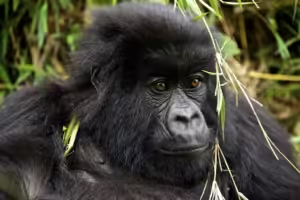9 MAJOR FACTS ABOUT SILVERBACK GORILLAS.
These detailed 9 major facts about silverback gorillas—an insight into the world of silverback gorillas, emphasize not only their strength and physicality but also their intelligence, emotional depth, and complex social structures.
Conservation efforts to protect these endangered creatures are vital to ensuring that future generations can continue to marvel at their majesty.
Gorilla trekking can be carried out in countries like Uganda, Rwanda and Congo, where amazing memories can be created with these human-like creatures in the natural habitats.
-
The Silverback: A Dominant & Intelligent Leader
With its iconic silver-streaked back, the male silverback gorilla is a commanding figure in the animal kingdom, symbolizing both physical strength and wisdom. As the dominant leader of its family troop, the silverback gorilla embodies authority and responsibility.
This magnificent ape is tasked with protecting its family, making critical decisions about where the group travels, feeds, and settles, as well as mediating any conflicts that may arise within the group.
However, the silverback’s leadership extends beyond sheer strength. Known for their gentle nature, silverbacks form strong emotional bonds with family members, particularly the young.
They play an active role in nurturing and raising their offspring, offering protection, guidance, and even affection.
In many ways, the silverback acts not only as the leader but also as a devoted father, showcasing a level of paternal care not commonly observed in the animal kingdom.
-
Shy and Gentle but Fiercely Protective
Despite being the largest and strongest of all primates, Silverback Mountain gorillas are surprisingly gentle and shy in nature.
These “gentle giants” often avoid conflict and aggression, opting instead for a peaceful existence of foraging and resting with their family troop.
Those fortunate enough to witness these creatures during gorilla trekking in Rwanda or Uganda often note their calm, reserved demeanor, especially when first encountering humans.
However, this gentleness should not be mistaken for weakness. When threatened or provoked, a silverback will become a formidable defender of its troop.
With its immense strength and protective instincts, a silverback can ward off predators or rivals in an impressive display of power.
Though silverbacks typically avoid aggressive displays, their defensive capabilities and speed, reaching up to 25 mph, are crucial for protecting their family from harm.
-
Deeply Family-Oriented Primates

Silverback gorillas live in close-knit social units called troops, usually led by a dominant male and consisting of several females and their offspring.
These groups are highly structured, with the silverback acting as the guardian and provider.
Family life is central to the social dynamics of these gorillas, and their interactions are filled with playfulness, cooperation, and learning.
Young gorillas learn essential life skills from both their parents and other troop members through play, mimicking behaviors, and observing the elders.
Females within the troop often share child-rearing duties, nurturing and caring for the young.
This intricate social structure reveals a remarkable level of intelligence and emotional complexity among gorillas, making their family dynamics a fascinating subject of study for researchers.
-
The Unique Gorilla Nose Print: Nature’s Fingerprint
One of the most intriguing facts about silverback mountain gorillas is that each one has a unique set of wrinkles above its nostrils, similar to human fingerprints.
This discovery, made by scientists in the 1950s, became essential for identifying and tracking individual gorillas.
Researchers began photographing and sketching the nose prints of various gorillas to build databases that catalog their individuality.
These nose prints, along with other physical features, allow scientists to monitor gorilla populations over time, helping them study behavioral patterns, migration habits, and even dietary preferences.
By tracking individuals this way, researchers can gain invaluable insights into the lives of these endangered creatures and work more effectively on conservation strategies.
-
Vegetarian Giants: A Surprising Diet
Despite their enormous size, silverback mountain gorillas are strict vegetarians.
Their diet primarily consists of stems, bamboo shoots, leaves, and fruits when available.
Living in the high-altitude regions of Central Africa, where fruits can be scarce, silverbacks have become adept foragers, often feeding on a variety of fibrous plants.
A typical adult male consumes over 18 kg (40 lbs.) of vegetation daily.
Silverbacks are particularly fond of banana tree pith, which they easily access by tearing apart trees with their powerful hands.
Interestingly, their diet not only sustains their impressive physiques but also plays a role in their environment.
By rotating their feeding grounds, silverbacks help ensure the vegetation has time to regenerate, demonstrating a form of sustainable foraging that benefits the ecosystem.
-
Rarely Drink Water: Hydration from Food
Silverback gorillas rarely drink water, a remarkable adaptation that suits their environment.
These primates obtain most of the moisture they need from the succulent vegetation they eat, such as leaves and stems, which contain high water content.
Additionally, they are known to lick morning dew off plants, further supplementing their water intake.
This efficient method of hydration allows gorillas to thrive in habitats where water sources are not always readily available.
Their avoidance of drinking water, as noted by renowned primatologist Dian Fossey, may also reflect their aversion to rain and wet conditions, which they seem to dislike.
-
Massive Size and Incredible Strength
Silverback gorillas are the largest primates in the world, with adult males weighing between 136 to 227 kg (300-500 lbs) and standing up to 6 feet tall.
Females are typically smaller, averaging about half the weight of males.
Despite their size, silverbacks are surprisingly agile and capable of reaching impressive speeds of up to 25 mph during short bursts of running.
The silverback’s strength is equally awe-inspiring.
They are estimated to be about 20 times stronger than the average adult human and are capable of lifting or throwing weights of up to 815 kg (1,800 lbs).
Additionally, their bite force—at 1,300 pounds per square inch—exceeds that of lions, thanks to their large canines and powerful jaws.
-
Chest Beating: A Powerful Form of Communication

One of the most iconic behaviors of the silverback gorilla is its chest-beating display, which serves as a multi-functional form of communication.
By standing upright and rhythmically pounding its chest with cupped hands, a silverback produces a sound that can be heard over a kilometer away.
This behavior is used to convey dominance, warn off potential threats, and even attract mates.
Interestingly, recent research shows that the pitch of a gorilla’s chest beat is linked to its size, with larger silverbacks producing lower-pitched sounds.
This sound acts as a signal to others, allowing them to assess the strength and size of the silverback, which can influence social interactions within and between troops.
-
Tool Users and Skilled Communicators
While chimpanzees are often celebrated for their tool use, silverback gorillas have also demonstrated their intelligence in this area.
They have been observed using sticks to test the depth of water or to assist their young in reaching higher branches for fruit.
These observations showcase their capacity for problem-solving and innovation in the wild.
Communication among silverbacks is also incredibly complex.
Gorillas have been recorded using over 25 distinct vocalizations to express a range of emotions, from contentment to alarm.
In one extraordinary case, a gorilla named Koko was taught sign language and learned over 1,000 signs while also understanding more than 2,000 English words.
This example illustrates the cognitive depth of gorillas and highlights their capacity for interspecies communication.
Plan and book your stay with Gecko Safaris.
As you plan to visit the lake, Gecko Safari Africa is available to help you with your hotel and lodge bookings and take you around the area for further experience, helping you capture a good number of memories while on your safari. Contact us via our inquiry office.



